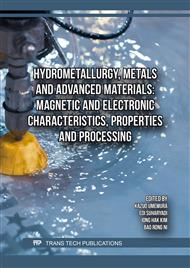[1]
M. Kato, G. Deng, K. Inoue, N. Takatsu. (1993). Evaluation of the Strength of Carburized Spur Gear Teeth Based on Fracture Mechanics. JSME International Journal. 36-2, pp.233-240.
DOI: 10.1299/jsmec1993.36.233
Google Scholar
[2]
M. Kamaya. (2013). Observation of Fatigue Crack Initiation and Growth in Stainless Steel to Quantify Low-Cycle Fatigue Damage for Plant Maintenance. E-Journal of Advanced Maintenance. 5, pp.185-200. ISSN-1883-9894/10 © 2010.
Google Scholar
[3]
Y. Murakami, T. Endo. (1983). Effects of small defects on fatigue strength of metals. Int. J. Fatigue. 2 (1), p.22–30.
DOI: 10.1016/0142-1123(80)90024-9
Google Scholar
[4]
H. Nishitani, N. Kawagoishi. (1992). Fatigue Crack Growth Laws in Small and Large Cracks and Their Physical Background. JSME International Journal. 35-1-C, pp.1-11.
DOI: 10.1299/jsmea1988.35.1_1
Google Scholar
[5]
S. Nasiri, M.R. Khosravani. (2022). Applications of data-driven approaches in prediction of fatigue and fracture. Materials Today Communications. 33, 104437.
DOI: 10.1016/j.mtcomm.2022.104437
Google Scholar
[6]
X.Q. Li, L.K. Song, G.C. Bai. (2022). Deep learning regression-based stratified probabilistic combined cycle fatigue damage evaluation for turbine bladed disks. Int. J. Fatigue. 159, 106812.
DOI: 10.1016/j.ijfatigue.2022.106812
Google Scholar
[7]
J. Li, Z. Yang, G. Qian, F. Berto. (2022). Machine learning based very-high-cycle fatigue life prediction of Ti-6Al-4V alloy fabricated by selective laser melting. Int. J. Fatigue. 158, 106764.
DOI: 10.1016/j.ijfatigue.2022.106764
Google Scholar
[8]
A. NUSSBAUMER. (2006). European standard for fatigue design of steel structures and perspectives. Int. Conf. on Fatigue and Fracture in the Infrastructure. Philadelphia, USA, pp.1-28.
Google Scholar
[9]
The Japan Society of Mechanical Engineers. (1991). Document for gear strength design. The Japan Society of Mechanical Engineers. p.6–49 (in Japanese). ISBN 4-88898-005-5.
Google Scholar
[10]
R. A. Gujar, S. V. Bhaskar. (2013). Shaft Design under Fatigue Loading by Using Modified Goodman Method. International Journal of Engineering Research and Applications. 3-4, pp.1061-1066. ISSN: 2248-9622.
Google Scholar
[11]
ISO. (2019). Calculation of load capacity of spur and helical gears - Part 3: Calculation of tooth bending strength. ISO 6336-3. ISO 6336-3:2019(en).
DOI: 10.3403/30359088
Google Scholar
[12]
K. Kawano, H. Nishitani. (1975). Bending or Torsional Fatigue of Notched Specimen with a Small Hole at the Notch Root. Bulletin of JSME. 18-115, pp.1-8.
DOI: 10.1299/jsme1958.18.1
Google Scholar
[13]
K. Zhang, S. Hamada, T. Yokoi, H. Noguchi. (2023). Significant reduction of fatigue crack non-propagation limit caused by damage accumulation mode fatigue crack propagation in a precipitation-hardened punched steel plate. Materials Science & Engineering. A 871, 144871.
DOI: 10.1016/j.msea.2023.144871
Google Scholar
[14]
N. Xu, Z. Fu, Y. Wang, X. Shen. (2022). Study on the short fatigue crack initiation and propagation behavior of 42CrMo. Advances in Mechanical Engineering. 14-9.
DOI: 10.1177/16878132221119928
Google Scholar
[15]
Siebel E, Stieler M. (1955). Significance of dissimilar stress distributions for cyclic loading. VDI-Z. 97, p.121–126.
Google Scholar
[16]
M. Braun, A. M. Müller, A. S. Milaković, W. Fricke, S. Ehlers. (2020). Requirements for stress gradient-based fatigue assessment of notched structures according to theory of critical distance. Fatigue & Fracture of Engineering Materials & Structures. 43-7, pp.1541-1551.
DOI: 10.1111/ffe.13232
Google Scholar
[17]
Deng G, Nakanishi. (2018). Bending fatigue strength design method for machine components with complex geometries. Frattura ed Integrità Strutturale. 46, pp.45-53.
DOI: 10.3221/IGF-ESIS.46.05
Google Scholar
[18]
L. Susmel. (2022). Notches, nominal stresses, fatigue strength reduction factors and constant/ variable amplitude multiaxial fatigue loading. International Journal of Fatigue. 162, 106941.
DOI: 10.1016/j.ijfatigue.2022.106941
Google Scholar
[19]
Little RE. (1972). Estimating the Median Fatigue Limit for Very Small Up-and-Down Quantal Response Tests and for Data with Runouts. Probabilistic Aspects of Fatigue. ASTM STP, 511, pp.29-41.
DOI: 10.1520/stp35403s
Google Scholar
[20]
Jeong B, Kato M, Inoue K, Takatsu N. (1992). The bending strength of carburized fine module gear teeth (carburizing conditions and their effects on the fatigue strength. JSME Int J. 35(1), pp.136-141.
DOI: 10.1299/jsmec1988.35.136
Google Scholar
[21]
A. Kurek. (2020). Using Fatigue Characteristics to Analyse Test Results for 16Mo3 Steel under Tension-Compression and Oscillatory Bending Conditions. Materials. 13(5), 1197.
DOI: 10.3390/ma13051197
Google Scholar
[22]
Japanese Standards Association. (2007). JIS Handbook, Steel. ISBN:9784542174818, JIS G 4051, p.1685 (in Japanese).
Google Scholar
[23]
E.J. Pavlina, C.J. Van Tyne. (2008). Correlation of Yield Strength and Tensile Strength with Hardness for Steels. Journal of Materials Engineering and Performance. 17, pp.888-893.
DOI: 10.1007/s11665-008-9225-5
Google Scholar
[24]
M. Braun, C. Fischer, J. Baumgartner, M. Hecht, I. Varfolomeev. (2022). Fatigue Crack Initiation and Propagation Relation of Notched Specimens with Welded Joint Characteristics. Metals. 12(4), 615, pp.1-24.
DOI: 10.3390/met12040615
Google Scholar


